As it happens, I am currently planning just such a trip: a Quest tour of Costa Rica in March. When I look ahead, my excited imagination immediately pictures the showy, colourful birds of the forest canopy. My thoughts are overrun with toucans, parrots, trogons, oropendolas, tanagers, and glittering hummingbirds in every colour of the rainbow. Tropical birding is a dazzling affair.
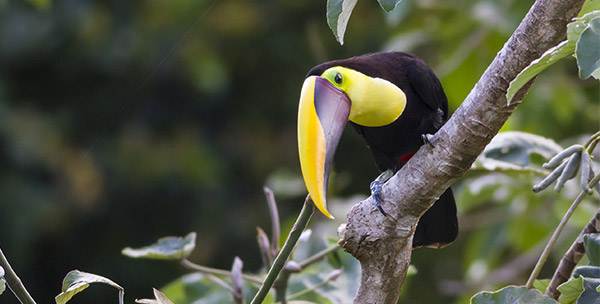
But when I return from a trip like this, I’m often surprised at which birds feature most prominently in my memories. I love the cartoonish toucans, for example (someone once described them to me as “a crow pushing a banana”, and I picture that every time I see one), but to me they are a bird of the moment. One that I enjoy and appreciate while it’s in front of me, but don’t ponder too much afterwards.
The birds that stick in my mind are the ones that take a more subtle approach to life. The shy, subdued, understory birds that nobody pictures when they think about the rainforest. Many of these birds have interesting behaviours or fascinating life histories but go overlooked or undetected by observers who are more interested in their colourful cousins. I think these birds deserve a little more love.
To that end, here are three of my favourite rainforest recluses from deep in the shade of the Central American canopy, and why you should give them a chance:
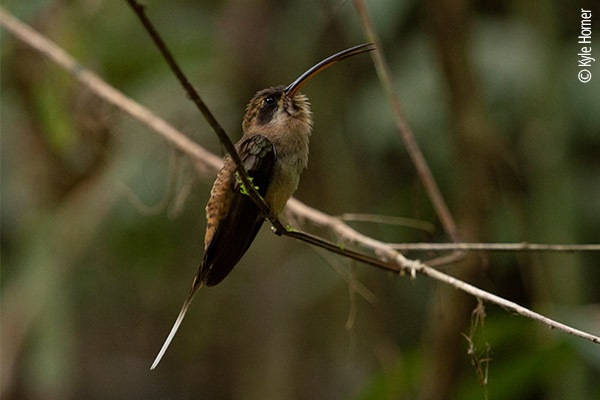
Long-billed Hermit
It may seem strange to start this trio with a hummingbird, but the Long-billed Hermit is not the tropical hummer of your imagination. It lacks the brilliant colours and sparkling adornments of many of its cousins, instead wearing simple brownish plumage with a white belly and black mask. It will visit feeding stations, where its large size and decurved bill make it easy to spot, but in the forest it is much sneakier indeed.
While many hummingbirds habitually visit and defend a small patch of flowers, the hermit is a “trapline” feeder. This means that it zips covertly through the trees, visiting flowers that are widely scattered over a large area. Between forays, it sits perfectly still on a twig, blending into its lush backdrop. A resting hermit is nearly impossible to spot, and you are likely to walk by one without ever knowing it was there.
Hear two Long-billed Hermits counter-singing in a lek
Unless, that is, the hermit is looking for a mate. When it’s the season for romance, male Long-billed Hermits gather in groups, spread out in the understory, and sing their little hearts out. This communal song-contest is called a lek, and it allows an interested female to survey her options and select the prettiest singer from among them.
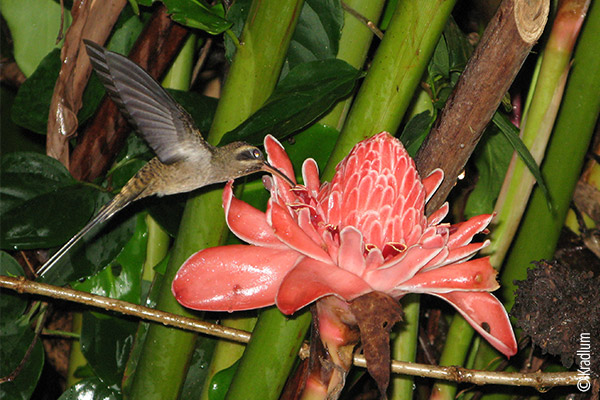
For a human, walking through a hermit lek is a fascinating and infuriating experience. The song – really just an emphatic squeak – is easy to hear, but getting eyes on the singer is another story. The singing males stand still, and their drab colours camouflage them perfectly. Inevitably you try to sneak up on one, only to have it stop singing just as you zero in on its location. I can’t count the number of hermits I have unsuccessfully stalked.
Ultimately patience and persistence is rewarded, and it’s a delight to spot one of these eager males, crooning for his future mate. The Long-billed Hermit is a hummer that does things a little differently, and it’s well worth searching for between toucans.
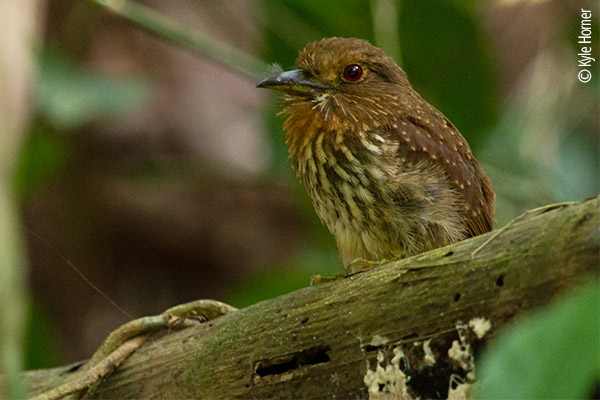
White-whiskered Puffbird
Puffbirds are relatives of woodpeckers and toucans, but that won’t help you picture one. With their stout bodies, big heads, and heavy bills, they have always reminded me more of kingfishers. They behave like kingfishers, too, sitting still on a strategic perch then sallying out and diving down for prey. Except that instead of fishing for fish, the puffbirds “fish” for invertebrates, frogs, and lizards on the forest floor or in the trees.
While you wouldn’t accuse the puffbirds of being gaudy, many in this family have smartly-contrasting plumage and enjoy exposed perches in the forest canopy. They’re not particularly hard to spot, especially if you have a keen eye for movement and are familiar with their vocalizations. But just like the Long-billed Hermit, the White-whiskered Puffbird is a little different from its family members.
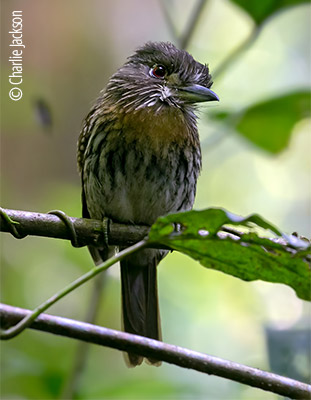
The White-whiskered is fairly small among the puffbirds, and prefers the dense understory to the forest canopy. There it sits alone on a concealed perch, and remains completely motionless for long periods. Its loose, mottled, brown plumage is a perfect imitation of sunlight filtering through the forest and dappling dry leaves, and it rarely vocalizes to betray its location.
Your best chance to see a White-whiskered Puffbird is to catch a rare flash of movement as it darts out to snatch a katydid or lizard, then returns to its perch to beat its victim on a branch before swallowing it. Once the meal is complete, in only a matter of seconds, the hunter may be still again for minutes or even hours. A great reminder to take a break from staring at parrots and lower your gaze to the forest floor.
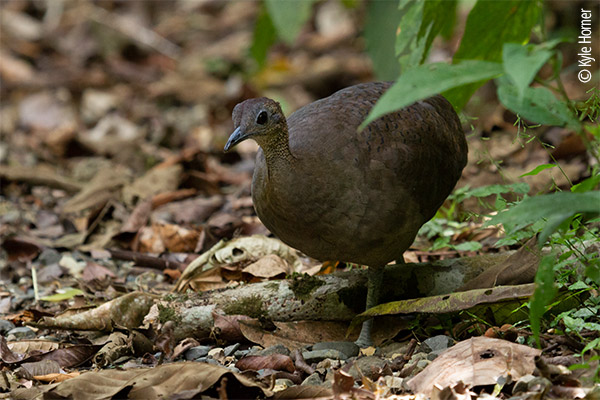
Great Tinamou
While the Long-billed Hermit and White-whiskered Puffbird are exceptions to their family rules, the Great Tinamou comes from a proud line of sneakers and skulkers. Tinamous are secretive, ground-dwelling birds that, on first glance, almost don’t appear to be birds at all. To imagine one, maybe picture a watermelon that has grown chicken legs and a tiny head with big, googly eyes. Then paint it brown, and the image will be complete.
The Great Tinamou is far more often heard than seen, and its wavering whistles are a regular feature of the rainforest soundscape. It is common throughout its range, but you’ll need luck on your side to spot one. The tinamou rarely leaves the forest floor and doesn’t move quickly. It just meanders slowly about, searching for fallen fruits and unattended seeds.
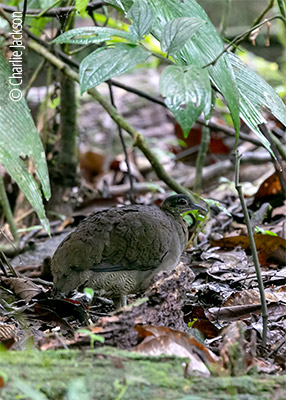
The Great Tinamou may look like a walking pile of dead leaves, but its unassuming appearance belies some formidable family relations. This bird is a ratite, making it a relative of the ostriches, emu, and cassowaries. It may not be the most spectacular member of this distinguished family, but the Great Tinamou is set apart by a very special party trick: it can fly.
Evidence would suggest that tinamous don’t like to fly – they do so rarely and in short bursts – but the fact that they can has consequences. For years, ornithologists believed that the flightless ratites evolved from some ancient, flightless ancestor. A flyer in the family suggests that these birds evolved to be flightless from an ancestor that wasn't. In this way, the unassuming tinamous are an important piece in the puzzle of bird evolution, and a bird well worth taking the time to search for.
The Great Tinamou, White-whiskered Puffbird, and Long-billed Hermit may be a tough sell in comparison to toucans and parrots, but these subdued rainforest birds are certainly among my favourites. They are easy to overlook, but in doing so you would miss out on a part of the tropical birding experience. The rainforest’s party piece is diversity, after all, and for every shimmering head-turner there is an understated, understory counterpart equally deserving of your attention.
Join Kyle Horner in
Classic Costa Rica: Quest for the Quetzal
February 22 - March 4, 2025 | Learn more
Classic Costa Rica: Quest for the Quetzal
February 22 - March 4, 2025 | Learn more



